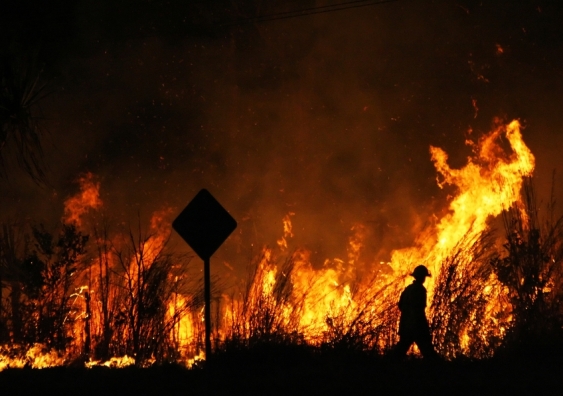Comprehending the Value of a Thorough BAL Assessment Report
Comprehending the Value of a Thorough BAL Assessment Report
Blog Article
The Value of Bushfire Management in Fire Defense
In the realm of fire defense, the importance of effective bushfire monitoring can not be understated. As areas worldwide come to grips with boosting instances of wildfires, the positive technique to stop and minimizing these natural catastrophes via strategic bushfire monitoring approaches has arised as a critical aspect. Past the prompt danger to human life and building, the interplay in between bushfire management and environmental conservation, area participation, and environment modification positions intricate obstacles that demand comprehensive services.
Relevance of Proactive Bushfire Avoidance
Aggressive bushfire prevention strategies are crucial in alleviating the ruining effects of wildfires on communities and communities. One essential element of aggressive bushfire avoidance is gas management.
Furthermore, producing firebreaks - removed areas where plants is tactically removed to create an obstacle to reduce or quit the development of a bushfire - is an additional essential positive procedure. By implementing these methods, the spread of wildfires can be restricted, safeguarding both human lives and the environment. Enlightening the public on fire security techniques and promoting area awareness concerning the relevance of bushfire prevention are important parts of proactive strategies. Inevitably, aggressive bushfire avoidance plays a considerable function in protecting communities and communities from the destructive effects of wildfires.
Function of Area Interaction in Fire Protection
Engaging the community in fire security initiatives is important to enhancing the performance of proactive bushfire avoidance strategies. Area engagement plays a vital duty in promoting a cumulative understanding of the threats posed by bushfires and the importance of preparedness procedures. By involving regional residents, authorities can disseminate vital information ablaze safety methods, discharge procedures, and early warning systems, equipping people to take proactive steps to secure their lives and homes.
By cultivating a culture of preparedness and collaboration, communities can strengthen their capability to respond successfully to bushfire emergencies, reducing the effect on residential properties and lives. Eventually, community involvement is a cornerstone of extensive fire defense methods, highlighting the importance of collective action in safeguarding vulnerable locations from the danger of bushfires.
Relevance of Wild Animals Preservation in Bushfire Administration
Conservation of wildlife plays a crucial role in reliable bushfire administration strategies, making certain the security of diverse ecological communities and biodiversity in fire-prone regions. Wild animals preservation is crucial as it adds to the general resilience of environments, aiding in their capability to recoup and endure from the influence of bushfires. By saving environments and shielding different varieties, the natural balance within these ecological communities is kept, which is necessary for their long-term health and wellness and sustainability.
Furthermore, wildlife preservation also assists in lowering the threat and intensity of bushfires. Healthy ecosystems with well-preserved wildlife populaces can work as natural firebreaks, reducing down the spread of fires and restricting their devastating potential (BAL Assessment). Particular animal species, like delving animals or birds that spread seeds, play special duties in avoiding fires or assisting in the post-fire regeneration of environments
Including wild animals preservation into bushfire monitoring techniques is not just vital for safeguarding biodiversity however likewise for promoting the general health and wellness and strength of communities when faced with raising fire threats.
Advantages of Strategic Gas Decrease Programs
Purposefully executing fuel reduction programs is essential in mitigating the risk and impact of bushfires in fire-prone regions. These programs entail controlled burning, mechanical clearing, and other approaches to decrease the quantity of flammable vegetation offered to fuel wildfires. By tactically reducing gas loads in crucial areas, such see this page as close to residential areas or crucial infrastructure, the intensity and spread of bushfires can be substantially reduced.
One of the primary advantages of fuel decrease programs is the enhancement of general fire strength in an ecosystem. By developing calculated fuel breaks and lowering the connection of greenery, these programs aid to interrupt the course of a bushfire, making it less complicated for firemans to extinguish the blaze and have. Furthermore, gas decrease programs can secure biodiversity by preventing exceedingly extreme fires that can devastate environments and intimidate wildlife populaces.
In addition, these programs can likewise safeguard human lives and building by reducing the threat of devastating fires that position a significant threat to communities. Inevitably, tactical gas decrease programs play an important duty in aggressive bushfire administration and cultivating a safer atmosphere for both individuals and nature.
Effect of Climate Modification on Bushfire Danger

Higher temperature levels result in drier plants, making it much more prone to ignition. Reduced rains in particular regions lengthens drought problems, further boosting the flammability of the landscape. Additionally, the altering environment has changed wind patterns and weather, resulting in even more irregular fire behavior and fast fire spread.
As the environment remains to change, the frequency and strength of bushfires are expected to increase, demanding a proactive and flexible strategy to bushfire administration. Approaches should progress to make up the transforming threat landscape, incorporating climate forecasts and taking into consideration lasting durability in fire monitoring planning. Dealing with the effect of climate modification on bushfire threat is crucial in establishing efficient approaches to shield lives, home, and the atmosphere.
Conclusion
Finally, aggressive bushfire avoidance, neighborhood involvement, wild animals conservation, strategic gas decrease programs, and factor to consider of environment change are essential components in efficient fire defense. By applying these methods, we look these up can better manage bushfire risks and shield both human lives and the atmosphere. BAL Assessment. It is important that stakeholders collaborate to focus on these procedures to decrease the disastrous effect of bushfires on communities and communities

As the environment proceeds to change, the frequency and strength of bushfires are anticipated to increase, requiring a positive and adaptive strategy to bushfire management.In final thought, proactive bushfire view it avoidance, area interaction, wild animals conservation, calculated fuel decrease programs, and factor to consider of climate modification are vital elements in reliable fire defense.
Report this page